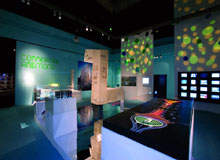
The Victoria and Albert Museum’s (V&A) China Design Now exhibition is a taste of the Chinese creative scene that will undoubtedly have a far greater impact on global popular culture as time progresses. This landmark exhibition presents work from over 100 designers and aims to provide what V&A director Mark Jones describes as a ‘snapshot’ of three Chinese cities at the forefront of design: Shenzen, Shanghai and Beijing.
EVOLUTION OF CHINESE DESIGN
Less than 20 years ago, Chinese designers were barely recognised outside the country. Until the early 90s only a handful of Chinese universities had design courses. Then the designers were the meigang, the ‘artist-workers’ working in state-owned companies.
In 2008 as the country prepares to host the Olympics, political reform might be advancing at a glacial pace but in architecture, fashion, graphic design and product design there has been an explosion of activity that has reflected China’s rapid, and seemingly relentless, rise.
The last decade in particular has seen many designers move away from formulaic socialist style to reinterpret old Chinese traditions in very modern ways. Western influences have helped craft a vibrant and trend-setting design scene.
SHENZEN

US Tariffs are shifting - will you react or anticipate?
Don’t let policy changes catch you off guard. Stay proactive with real-time data and expert analysis.
By GlobalDataOne of the youngest and newest of all China’s cities, with an average age of 27 and a population of ten million, Shenzen is an obvious choice to open the exhibition. A centre for Chinese graphic design for decades, Shenzen is today the world’s largest manufacturing zone and is a hyper real epicentre of creativity.
Near Hong Kong, Shenzen has benefited considerably from proximity to its once British neighbour, where artistic freedoms and influences that trickled over the ‘bamboo curtain’ was eagerly received. The resultant graphic art of posters, books, magazines – even skateboards – is exhilarating stuff from the work of Qian Qian Jiang Jiang to the Red Flag magazines created by a young Ai Weiwei, today an architect and designer and one of China’s foremost cultural commentators.
SHANGHAI
China’s gate to the west since the 20s, Shanghai has been at the forefront of modern technology and design. Always the consumer city, Shanghai is the new China at its most ostentatious and capitalist, both fascinating and disturbing in equal measure.
The exhibition shows how the Chinese aspire to live. Of particular interest are the models of the palatial dream homes on display, complete with a BMW in the garage. California retreats to mock Tudor mansions and Jiang-nan courtyard houses show how the house design replicates and evolves. This demand for luxury is underlined by being informed of the four great things that indicate the good life in China: the modern mantra of houses, cars, computers and mobile phones.
BEIJING
Beijing brings the future to the now. With the Imperial Palace calling Beijing home since 1420, the capital is the political and cultural centre of China and is where the Chinese have sought to visualise their emergent superpower status in the grandest way with the help of the finest architects the world can offer including Jacques Herzog and Pierre de Meuron, Rem Koolhaas, Norman Foster. These architects’ Chinese portfolios are magnificent but make no illusions about their big capitalist intentions.
Thankfully the exhibition does not focus entirely on the Beijing National Stadium, the CCTV Headquarters or Beijing International Airport Terminal 3, but gives an insight into how an East Asian architectural language is emerging. Chinese architecture has come a long way considering that it was only in the early 90s that the Chinese government allowed individual architects to set up their own practices.
Today even official institutions have created separate studios for commercial, architectural and planning projects. Architects like Yung Ho Chang and Ma Qingyun worked internationally for a few years before returning o China to work privately.
CHINA DESIGN NOW
China Design Now showcases work including Studio Pei Zhu’s brilliant design for the Olympic Media Centre, Digital Beijing and Ma Yansong’s sleek yet imposing SINOSteel International Plaza in Tianjin. Yansong is one of the youngest architects in China to win international commissions and is an example of where Chinese commercial architecture could be headed. Elsewhere local innovation is apparent in the work of Studio 8 and its Guangming Smart City project, where housing and organic farming has been vertically stacked into a series of suburban towers.
Looking to the nation’s past for inspiration, Ma Qingyun’s Father’s House evokes a farm villa from 700AD built for the Chinese poet Wang Wei. It’s a simple, delightful rustic design that connects the house with the local landscape and challenges popular perception about China’s insatiable appetite for tall things modern.
If you want to examine Chinese design today, comparisons with its greatest neighbour and rival Japan will inevitably surface.
Japan is unquestionably one of the top design capitals of the world and it’s unfair to compare it to China and its fledgling creative design industry. Paradoxically, Chinese mass design is everywhere in the billions of products feeding a global disposable culture. For Chinese design that is an original, expressive cultural / counter cultural force, the world is going to have to wait a bit longer.
China Design Now will be at the Victoria and Albert Museum in London until 13 July.



